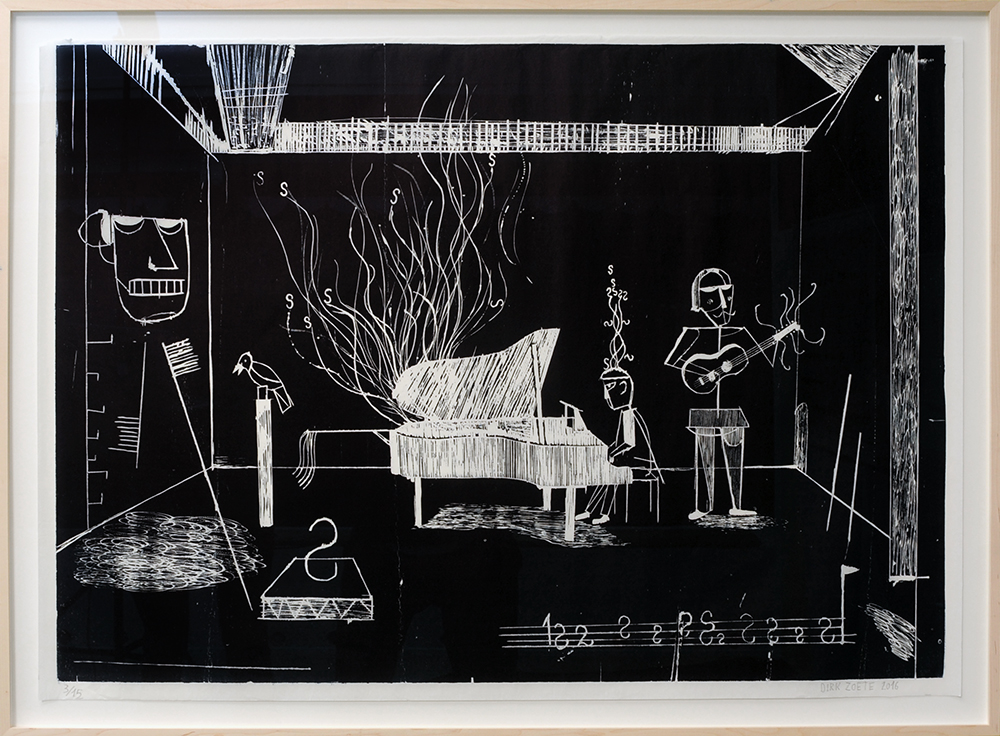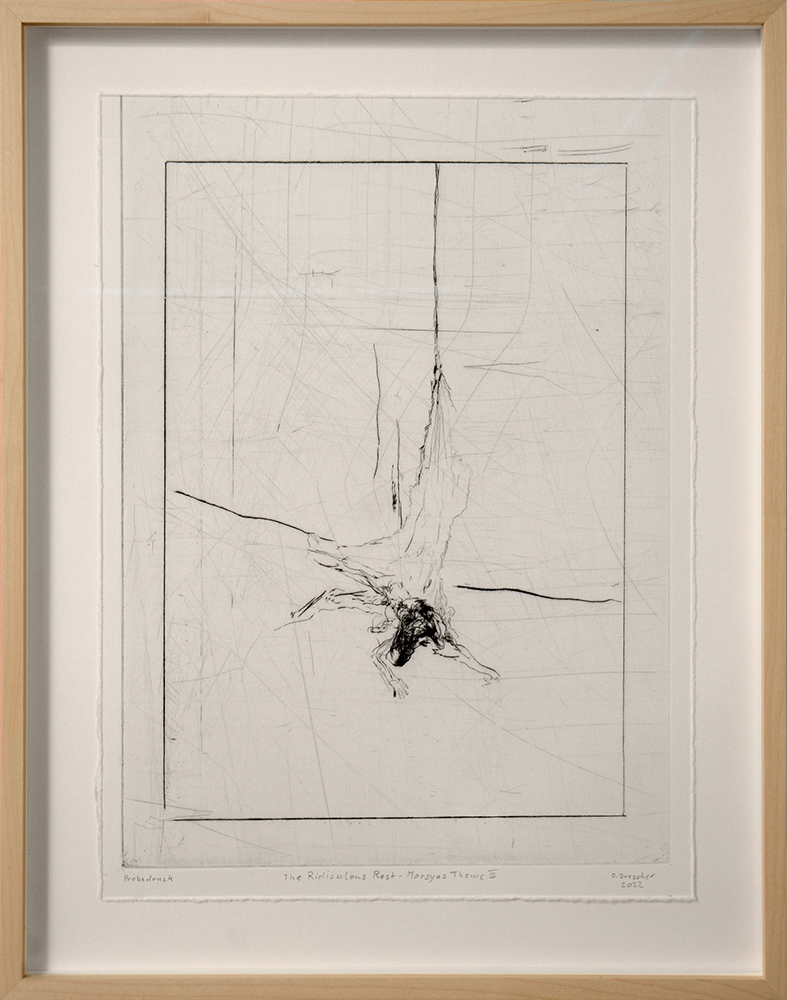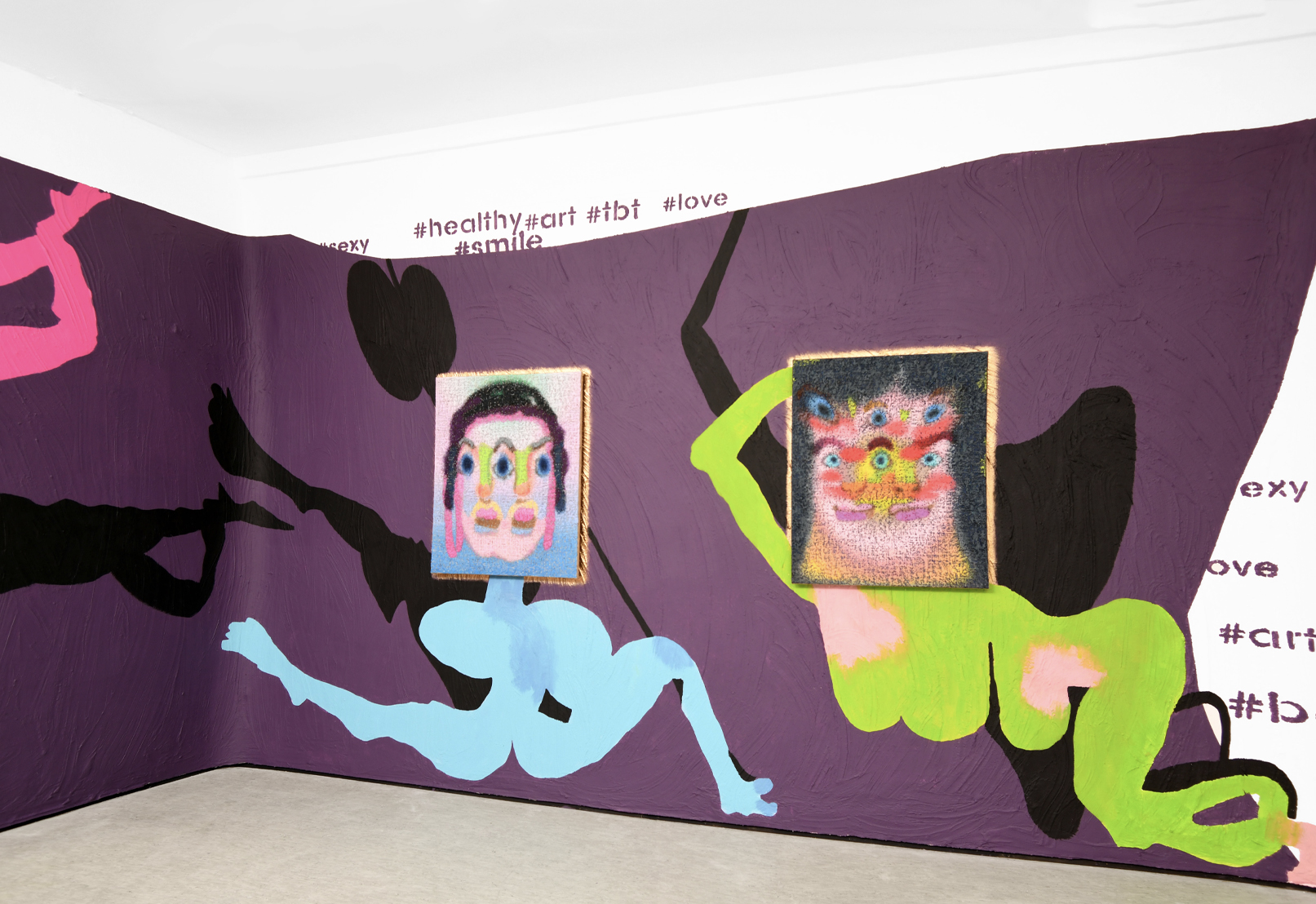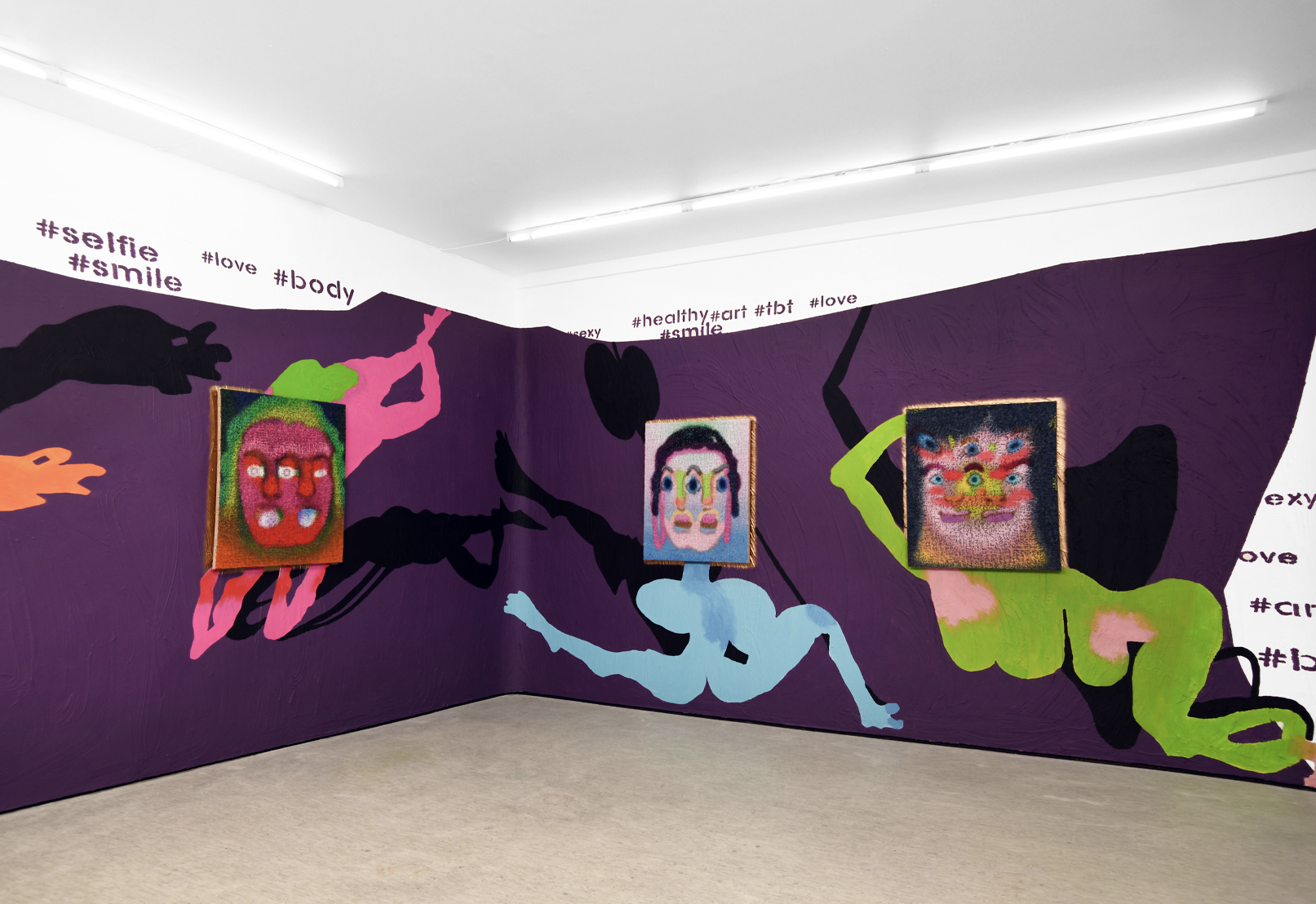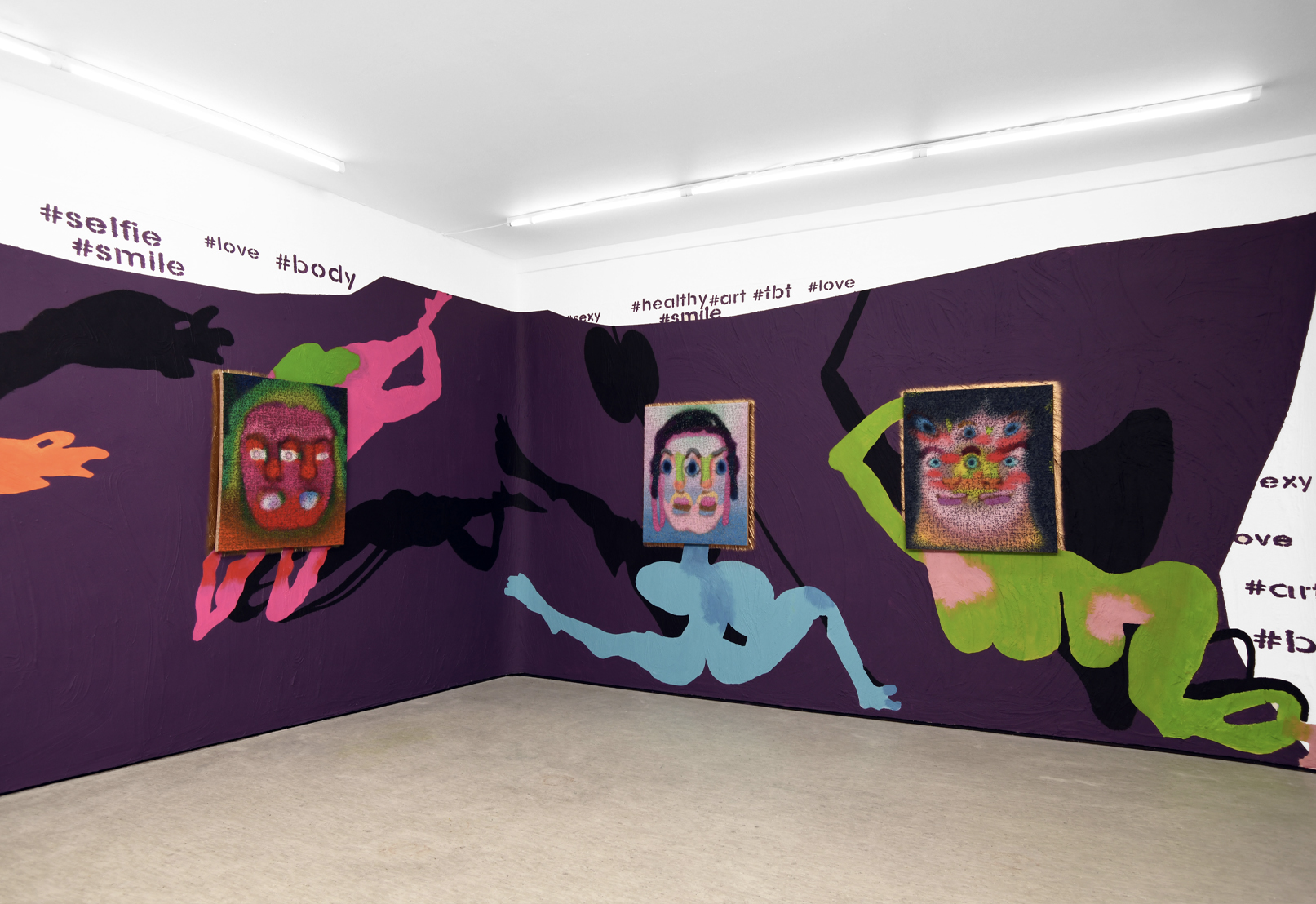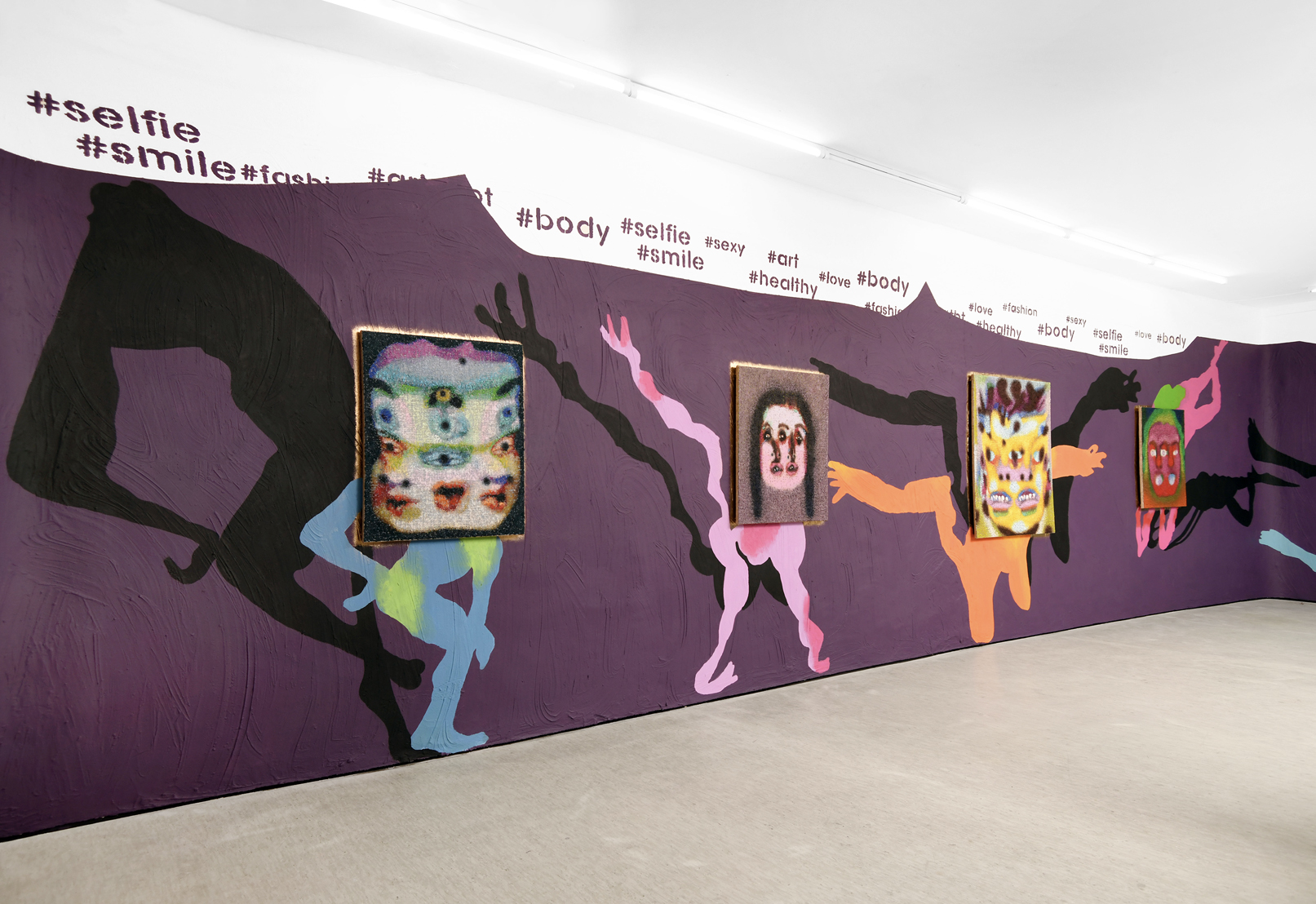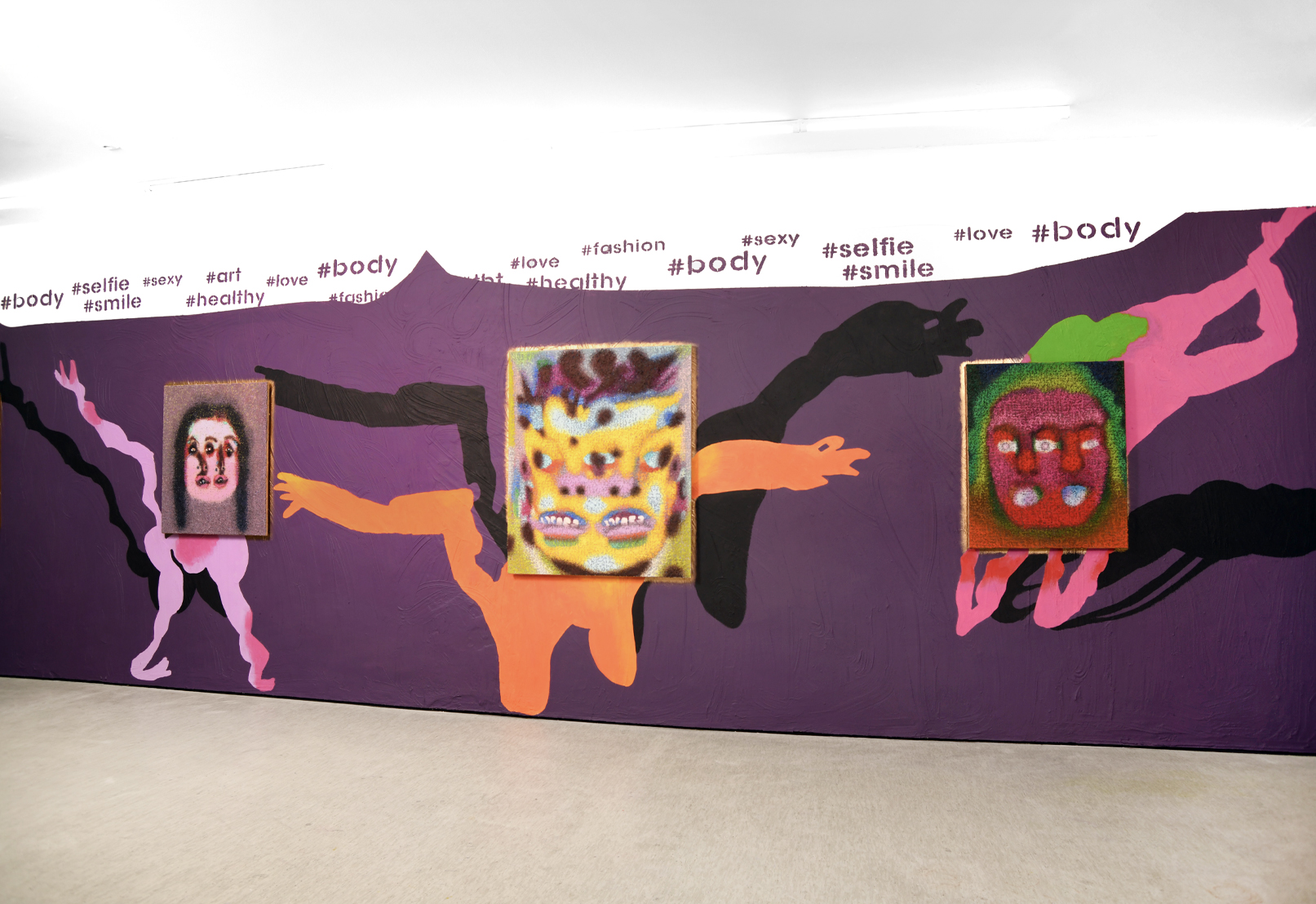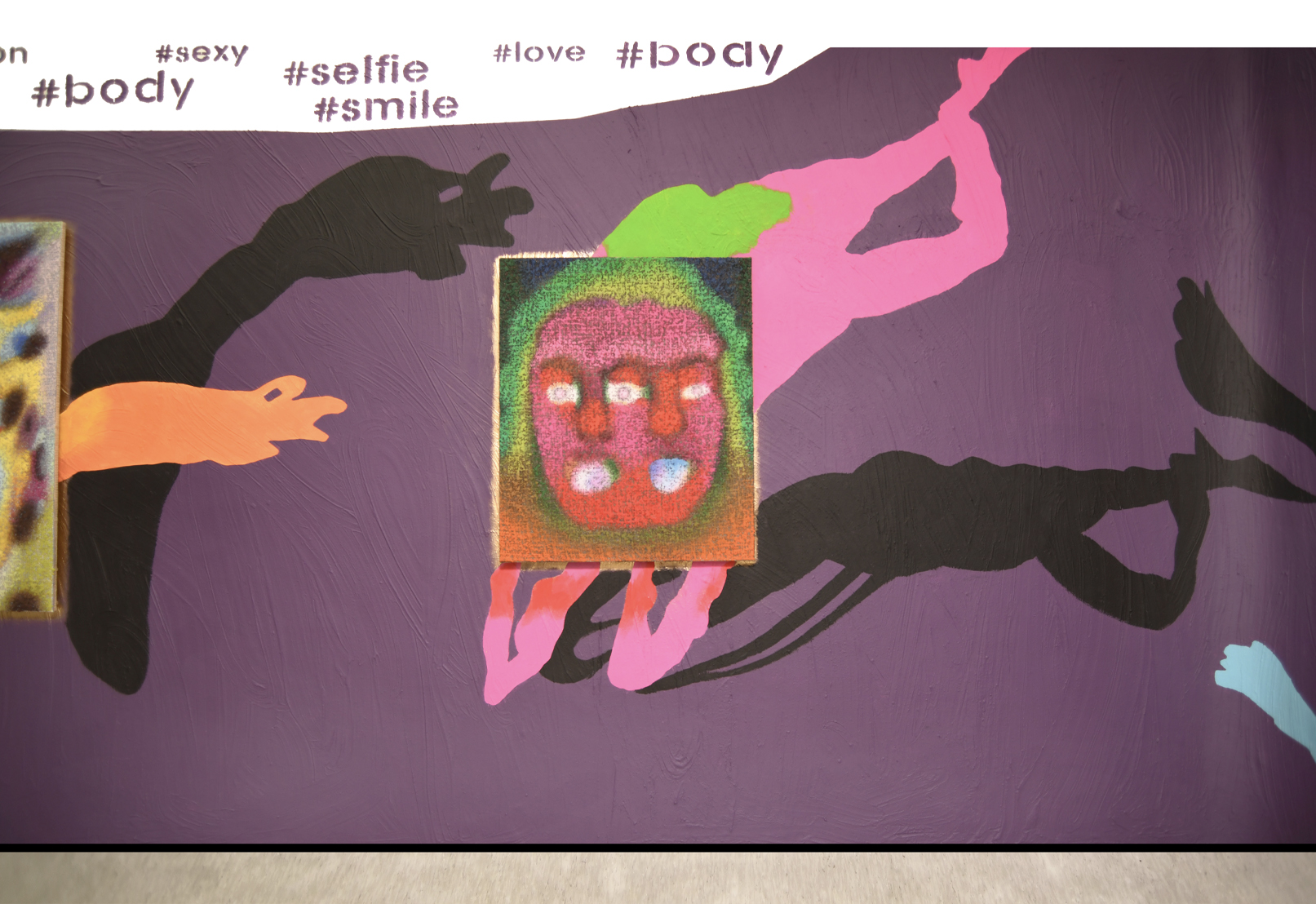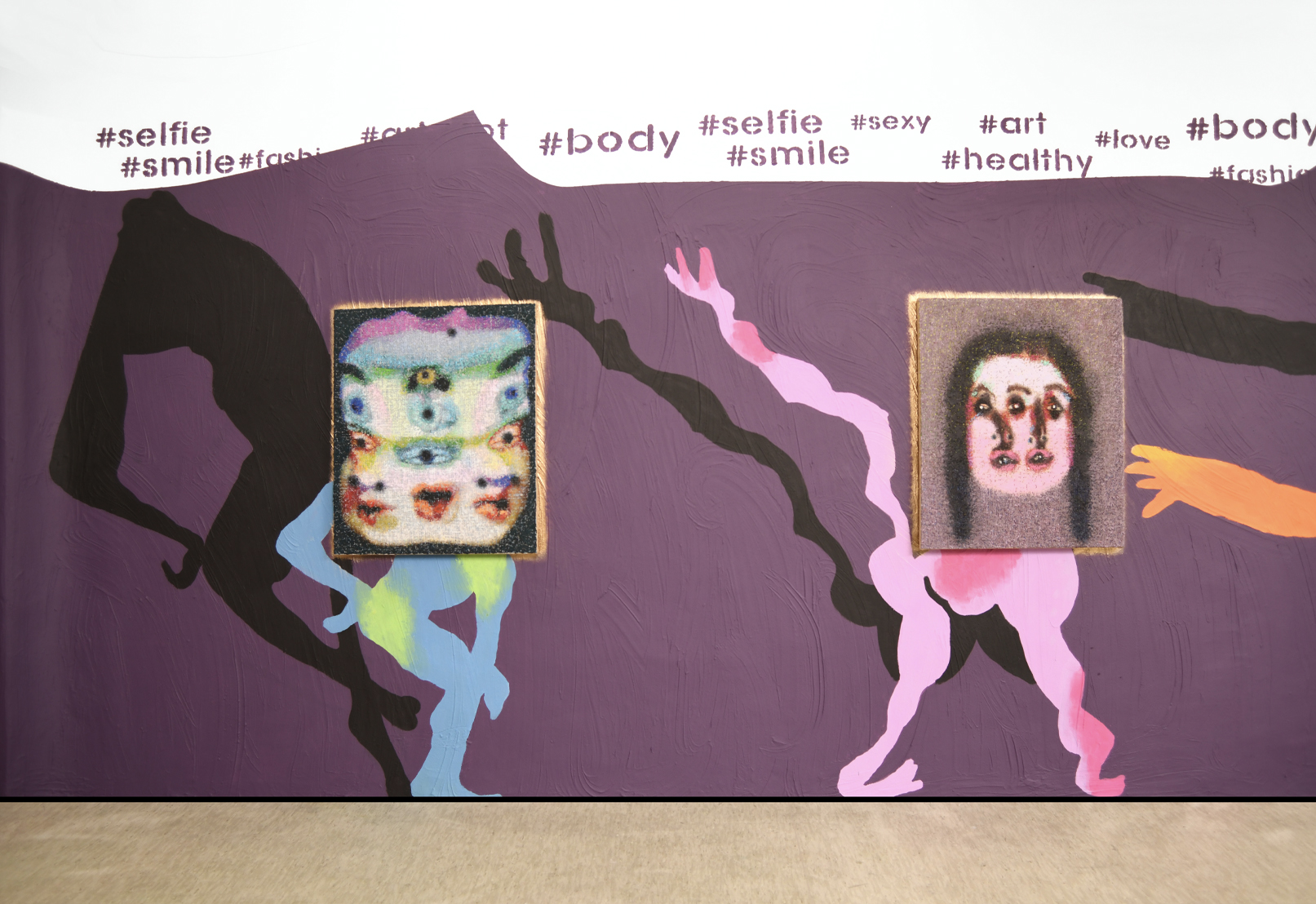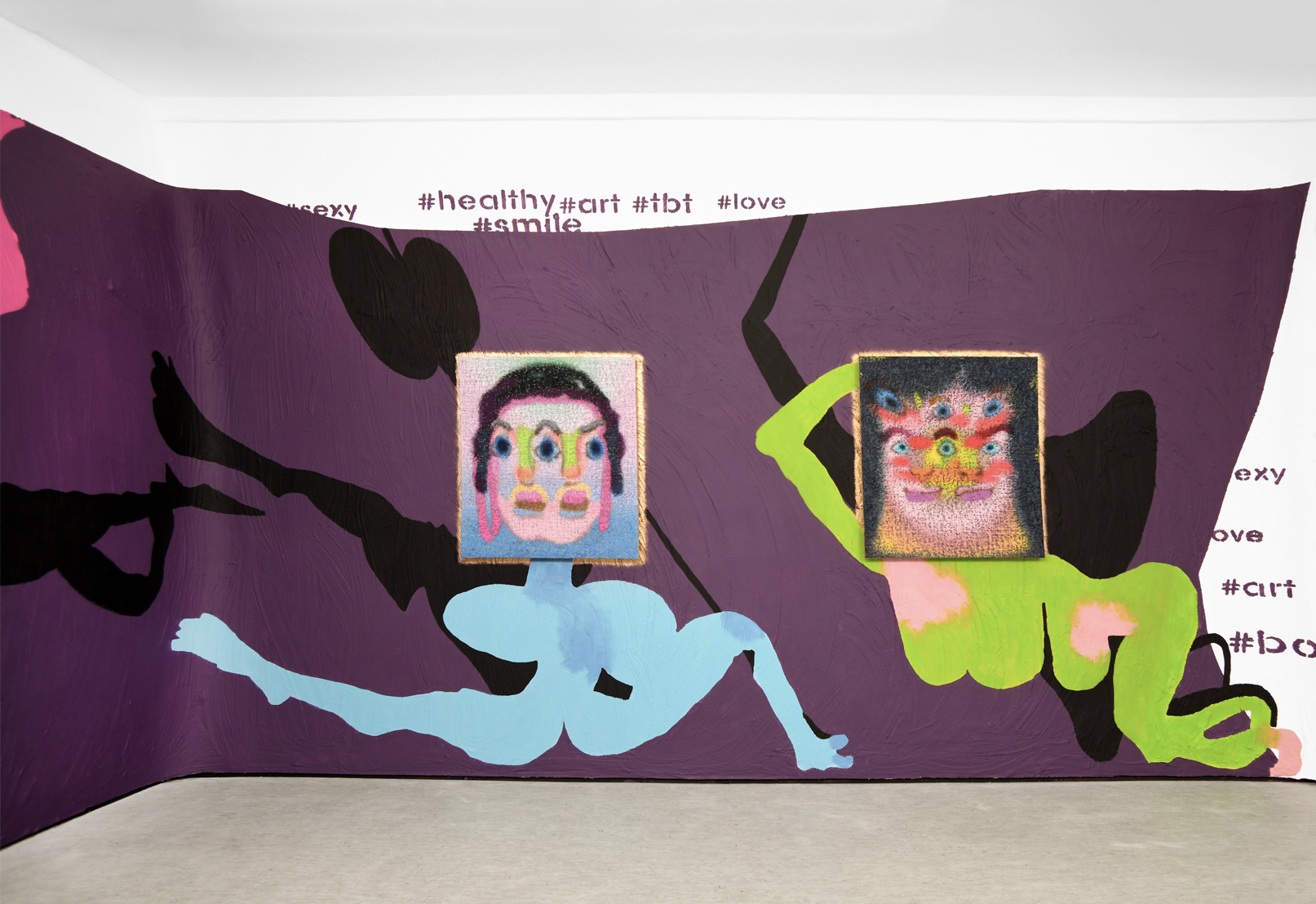Inna Levinson: Sonic Tweedledum : Verena Kerfin Gallery, Köthener Strasse 28, 10963 Berlin
Past
exhibition
Overview
The exhibition Sonic Tweedledum by Inna Levinson presents 9 paintings showing funny looking heads with three eyes, several mouths,
two noses, etc. Sometimes they look like double-mirrored heads, sometimes Janus-faced, sometimes like Diprosopus deformities, sometimes like exhilarated saints, sometimes like kaleidoscopically thrown together cheerful kits that have been neglected to count components.
The additional wall painting gives each of these portraits a radiantly coloured body on a dark background. This appears as if moved by the wind, tied to the solid rectangles of the canvases, partly as if fluttering or partly as if gently laid down.
The double- or multi-facedness of the characters does not seem like two disparate beings pressed together, but rather like a multiplying and complementary being, like Lewis Carroll’s identical brothers Tweedledee and Tweedledum in the book "Through the Looking-Glass and what Alice Found There" (1871), who cannot contradict each other, even if they claim the opposite. The two lie on staggered days and speak the truth on the other days. Who to trust and who not to trust depends not only on the day and the logic, but also on what the other person is willing to hear. If one now slips into the two brothers, unites them in one's own imagination as one figure and then observes the fictitious viewer, one notices that the viewer’s image is shaped by wishful thinking of his counterpart.
This perception is reinforced by quite funny cognitive effects. The well-known halo effect, for example, describes how interpersonal judgements are shifted by a positive association. Because with the halo effect, one concludes on the basis of known, positive characteristics of a person that other (as yet unknown) characteristics must also be positive. So once we have unconsciously decided on an illogical but sympathetic view of a person, the psyche still automates this impression other qualities that we cannot know. Even if we have chosen the tweedledee's version of a day when he is lying.
This halo effect might offer an explanation why people almost manically generate a positive portrayal of themselves in social media. The other side that contradicts this, i.e. Tweedledum remains in reality and is not visible to the viewer of the account. Many positive postings thus generate a positive basic attitude towards the person and their other actually unknown characteristics.
We cannot help but envy Alice. The way she looks at this contradictory world and is amazed, she seems like a very wise child, like one who can logically decipher the diversity of what is presented and is amazed at the intricacy. If we draw on another young person whose story is one of awkwardness and tragedy, then perhaps it becomes clearer to us what tools we are equipped with to unravel the world of contradictions.
Narcissus, a beautiful youth, was ensnared and stalked by adorers of both sexes. He could not accept the adoration offered to him, let alone return it; he tried to evade this desire, which was incomprehensible to him. Only when he saw himself, one can try to interpret it, did he link the outer world with the inner world, because only by looking at and experiencing others one can perceive oneself better and vice versa. The danger of forgetting the outside world and losing oneself in the inner world is shown in the myth as a danger that leads to death; today we see it in a somewhat less severe light and psychopathologise the danger as narcissism. What is so easy for the adult child Alice, to wonder about the simplest ambivalences, seems insurmountable to the young Narcissus.
Another entertaining cognitive effect of modern psychology perhaps better describes Narcissus' drastic behaviour. The mere-exposure effect describes how repeated perception of something initially judged neutral results in its more positive evaluation. Thus, familiarity with a person makes him seem more attractive and likeable. And Narcissus made himself familiar with himself. Thus, a psychology textbook smilingly advises: if you are not beautiful or your admiration for someone is not reciprocated, be persistent and stay close. Closeness and familiarity are your strongest weapons. - Textbook of Psychology (Atkinson, Atkinson, Smith, Bem & NolenHoeksema, 2000).
The one-sidedness of a falsely pointed aesthetic, which was the basis for an exaggeration of the individual, in the decadent art culture of the 19th century led to a literature that demonstrated the failure of aesthetic narcissism. A Dorian Grey by Oscar Wilde or a Tadzio in “Death in Venice” by Thomas Mann bear witness to this. At the turn of the century around 1900, a period just as marked by the self-reflection of aesthetic thought and poetry as that around 1800, the narcissistic stories from German literature mentioned above mark a self-critical position of an extreme anti-bourgeois aesthetic programme. Not only do they find in the image of Narcissus a symbol for the closed space of aestheticist self-reflektion, but through the adaptive repetition of the unhappy love and development story, they represent the problematic of the sterile self-consciousness of idolised art. This time, the aesthetic narcissist gazes not only at his fascinating reflection, but also at his fatal fate therein.
Thus, the theme of mirroring in social media captured by the artist and the power therein between the ambivalences of self-alienation and self-lostness, would be a recurring theme in cultural experience, apparently leading to a renaissance of the unfinished question through newly digital means such as smartphones: Who am I and who am I through the gaze of others. Obviously, this question has not been fully answered to satisfaction for a very long time, so that each generation makes an attempt with its tools to sound out the most favourable point between loss of self and narcissistic-aesthetic prison - to survive.
A small infant with a double face (Diprosopus malformation), who unfortunately was not viable, had a temple built on its grave in India; he was revered as a saint and as reincarnation during his lifetime. Symbols that are perhaps meant to express that the ordinary human being is caught in these ambivalences and cannot escape them. These malformations are the result of the disruption of a protein important for healthy development, named after the well-known computer game character Sonic the Hedgehog; it is called Sonic - Hedgehog in technical language. A beautiful image - a raging hedgehog that, when it works well as a protein, produces a healthy being that has an ambivalent world to navigate.
The artist gets one foot behind the mirror with her paintings and perceives the double world of the tweedledee and the tweedledum. Confusing, but funny.
The double- or multi-facedness of the characters does not seem like two disparate beings pressed together, but rather like a multiplying and complementary being, like Lewis Carroll’s identical brothers Tweedledee and Tweedledum in the book "Through the Looking-Glass and what Alice Found There" (1871), who cannot contradict each other, even if they claim the opposite. The two lie on staggered days and speak the truth on the other days. Who to trust and who not to trust depends not only on the day and the logic, but also on what the other person is willing to hear. If one now slips into the two brothers, unites them in one's own imagination as one figure and then observes the fictitious viewer, one notices that the viewer’s image is shaped by wishful thinking of his counterpart.
This perception is reinforced by quite funny cognitive effects. The well-known halo effect, for example, describes how interpersonal judgements are shifted by a positive association. Because with the halo effect, one concludes on the basis of known, positive characteristics of a person that other (as yet unknown) characteristics must also be positive. So once we have unconsciously decided on an illogical but sympathetic view of a person, the psyche still automates this impression other qualities that we cannot know. Even if we have chosen the tweedledee's version of a day when he is lying.
This halo effect might offer an explanation why people almost manically generate a positive portrayal of themselves in social media. The other side that contradicts this, i.e. Tweedledum remains in reality and is not visible to the viewer of the account. Many positive postings thus generate a positive basic attitude towards the person and their other actually unknown characteristics.
We cannot help but envy Alice. The way she looks at this contradictory world and is amazed, she seems like a very wise child, like one who can logically decipher the diversity of what is presented and is amazed at the intricacy. If we draw on another young person whose story is one of awkwardness and tragedy, then perhaps it becomes clearer to us what tools we are equipped with to unravel the world of contradictions.
Narcissus, a beautiful youth, was ensnared and stalked by adorers of both sexes. He could not accept the adoration offered to him, let alone return it; he tried to evade this desire, which was incomprehensible to him. Only when he saw himself, one can try to interpret it, did he link the outer world with the inner world, because only by looking at and experiencing others one can perceive oneself better and vice versa. The danger of forgetting the outside world and losing oneself in the inner world is shown in the myth as a danger that leads to death; today we see it in a somewhat less severe light and psychopathologise the danger as narcissism. What is so easy for the adult child Alice, to wonder about the simplest ambivalences, seems insurmountable to the young Narcissus.
Another entertaining cognitive effect of modern psychology perhaps better describes Narcissus' drastic behaviour. The mere-exposure effect describes how repeated perception of something initially judged neutral results in its more positive evaluation. Thus, familiarity with a person makes him seem more attractive and likeable. And Narcissus made himself familiar with himself. Thus, a psychology textbook smilingly advises: if you are not beautiful or your admiration for someone is not reciprocated, be persistent and stay close. Closeness and familiarity are your strongest weapons. - Textbook of Psychology (Atkinson, Atkinson, Smith, Bem & NolenHoeksema, 2000).
The one-sidedness of a falsely pointed aesthetic, which was the basis for an exaggeration of the individual, in the decadent art culture of the 19th century led to a literature that demonstrated the failure of aesthetic narcissism. A Dorian Grey by Oscar Wilde or a Tadzio in “Death in Venice” by Thomas Mann bear witness to this. At the turn of the century around 1900, a period just as marked by the self-reflection of aesthetic thought and poetry as that around 1800, the narcissistic stories from German literature mentioned above mark a self-critical position of an extreme anti-bourgeois aesthetic programme. Not only do they find in the image of Narcissus a symbol for the closed space of aestheticist self-reflektion, but through the adaptive repetition of the unhappy love and development story, they represent the problematic of the sterile self-consciousness of idolised art. This time, the aesthetic narcissist gazes not only at his fascinating reflection, but also at his fatal fate therein.
Thus, the theme of mirroring in social media captured by the artist and the power therein between the ambivalences of self-alienation and self-lostness, would be a recurring theme in cultural experience, apparently leading to a renaissance of the unfinished question through newly digital means such as smartphones: Who am I and who am I through the gaze of others. Obviously, this question has not been fully answered to satisfaction for a very long time, so that each generation makes an attempt with its tools to sound out the most favourable point between loss of self and narcissistic-aesthetic prison - to survive.
A small infant with a double face (Diprosopus malformation), who unfortunately was not viable, had a temple built on its grave in India; he was revered as a saint and as reincarnation during his lifetime. Symbols that are perhaps meant to express that the ordinary human being is caught in these ambivalences and cannot escape them. These malformations are the result of the disruption of a protein important for healthy development, named after the well-known computer game character Sonic the Hedgehog; it is called Sonic - Hedgehog in technical language. A beautiful image - a raging hedgehog that, when it works well as a protein, produces a healthy being that has an ambivalent world to navigate.
The artist gets one foot behind the mirror with her paintings and perceives the double world of the tweedledee and the tweedledum. Confusing, but funny.
Installation Views
Works
-
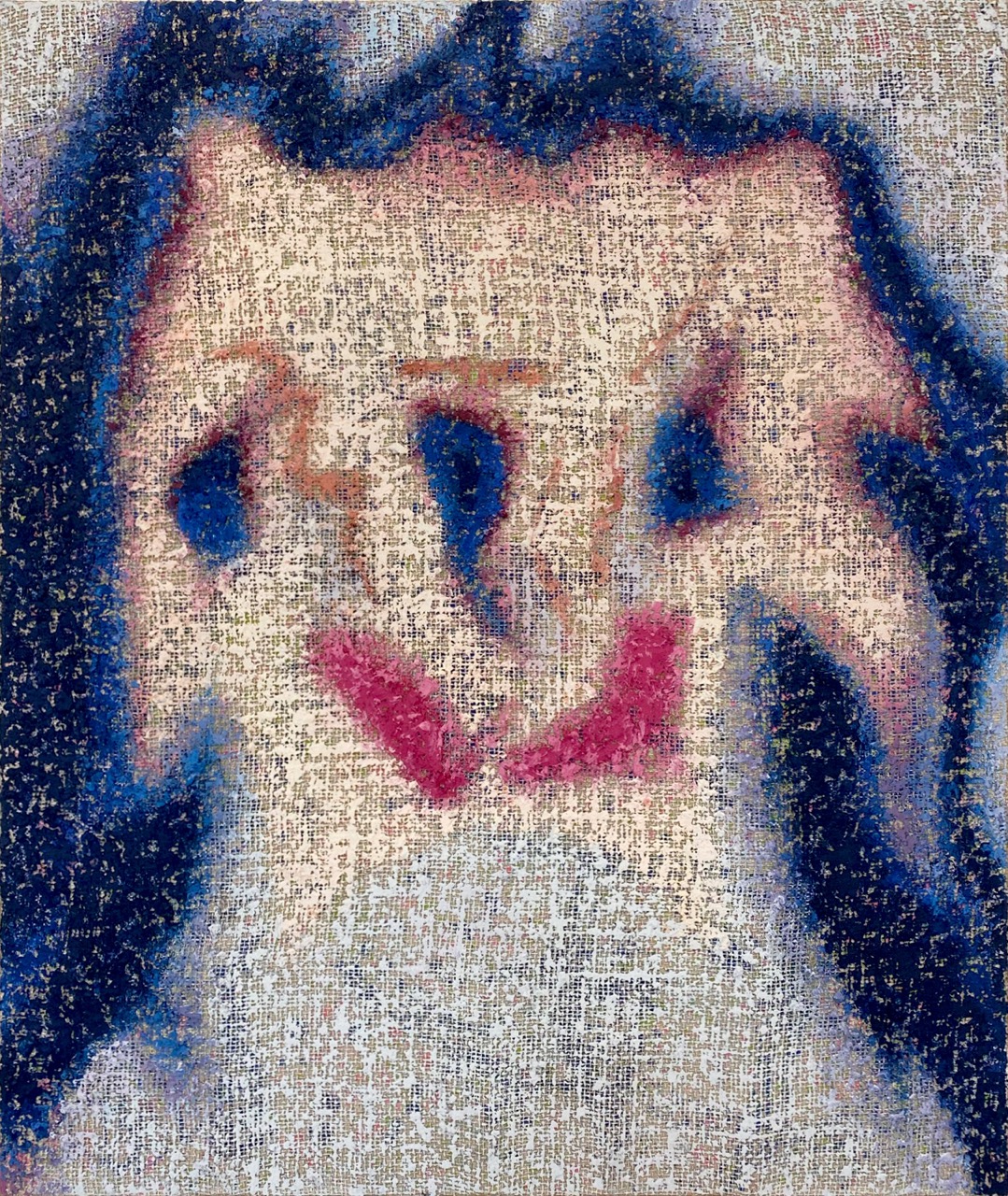 Inna LevinsonExistential Crisis, 2022
Inna LevinsonExistential Crisis, 2022 -
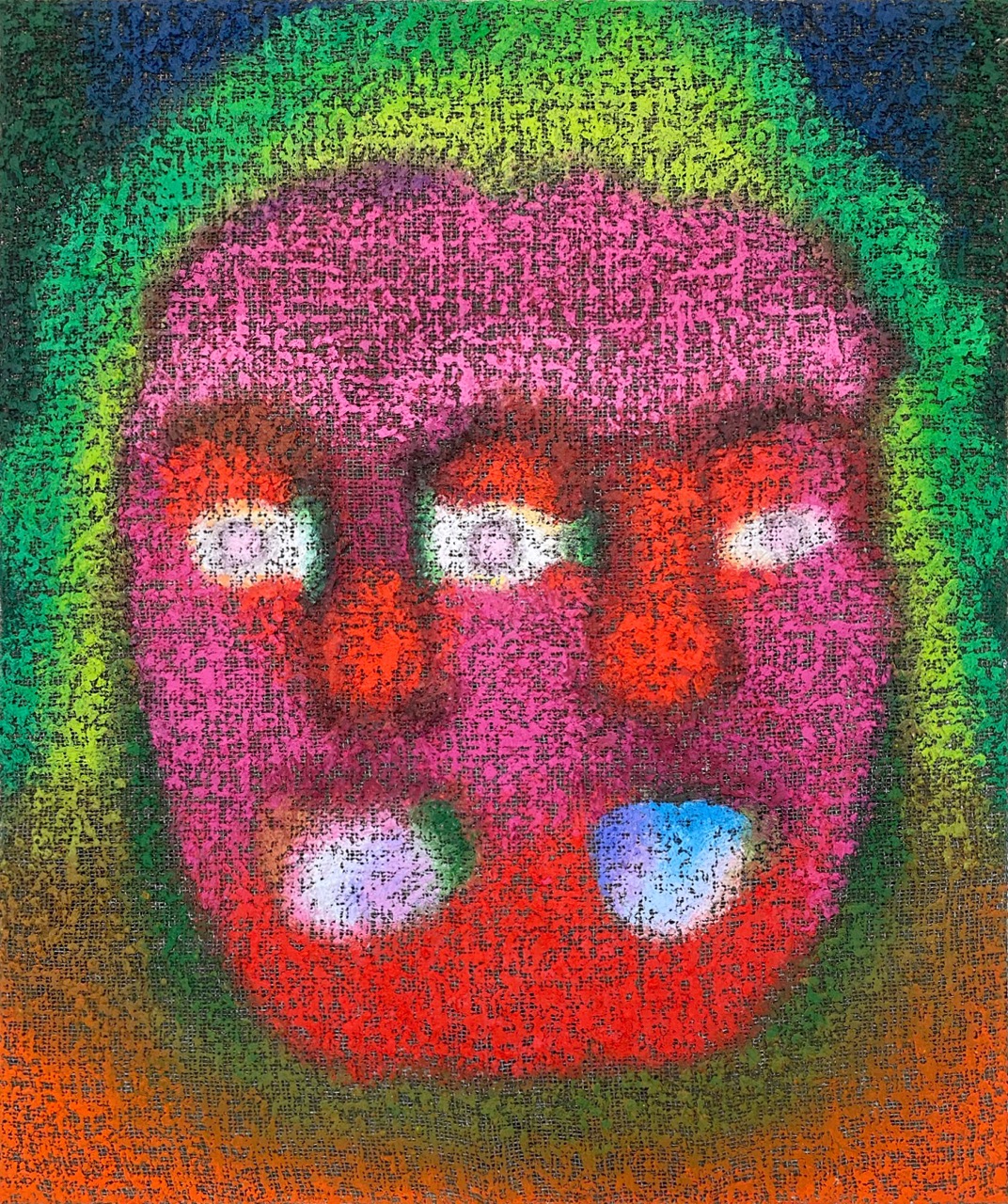 Inna LevinsonDouble-Faced (6), 2022
Inna LevinsonDouble-Faced (6), 2022 -
 Inna LevinsonDouble-Faced (7), 2022
Inna LevinsonDouble-Faced (7), 2022 -
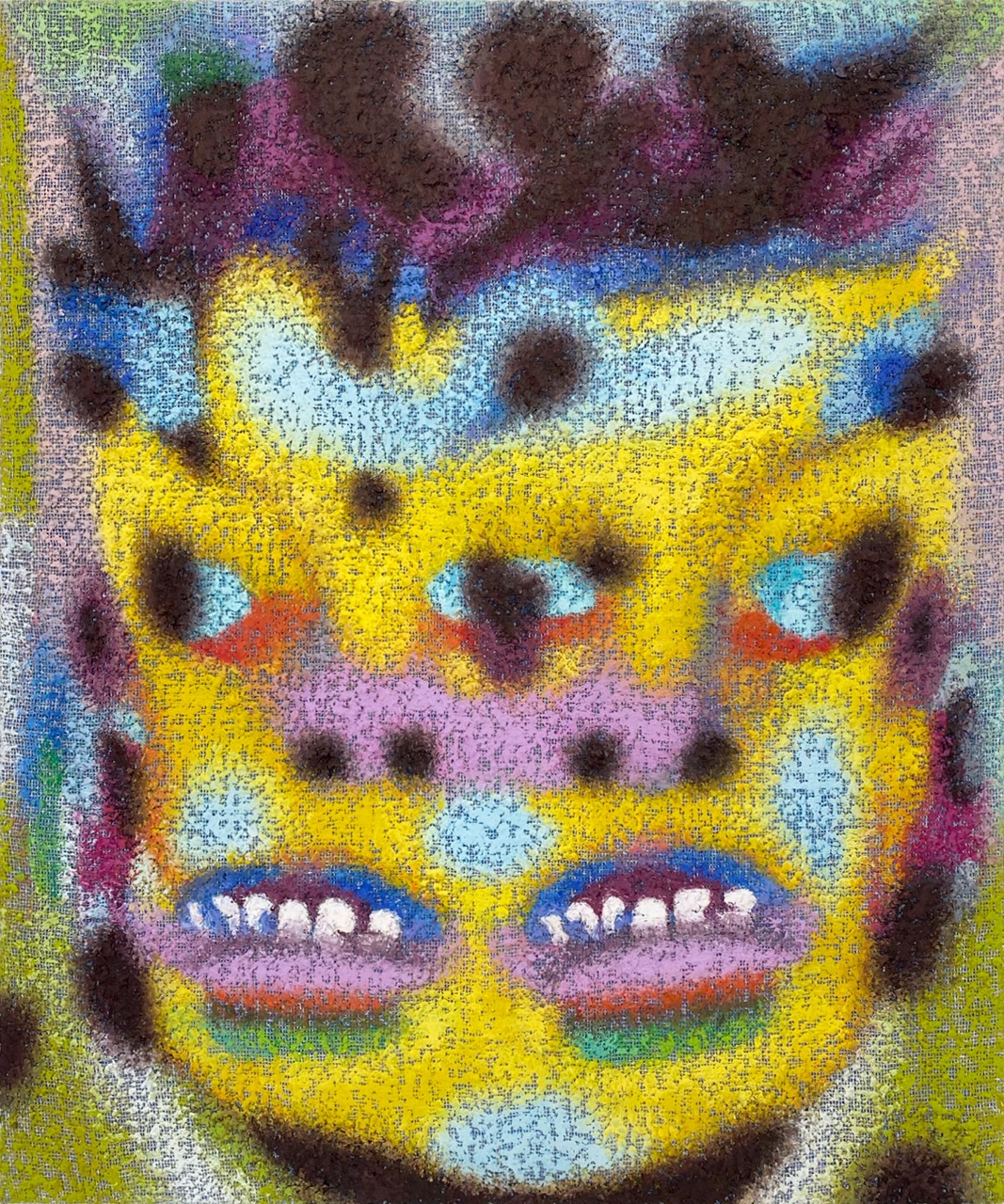 Inna LevinsonDouble-Faced (8), 2022
Inna LevinsonDouble-Faced (8), 2022 -
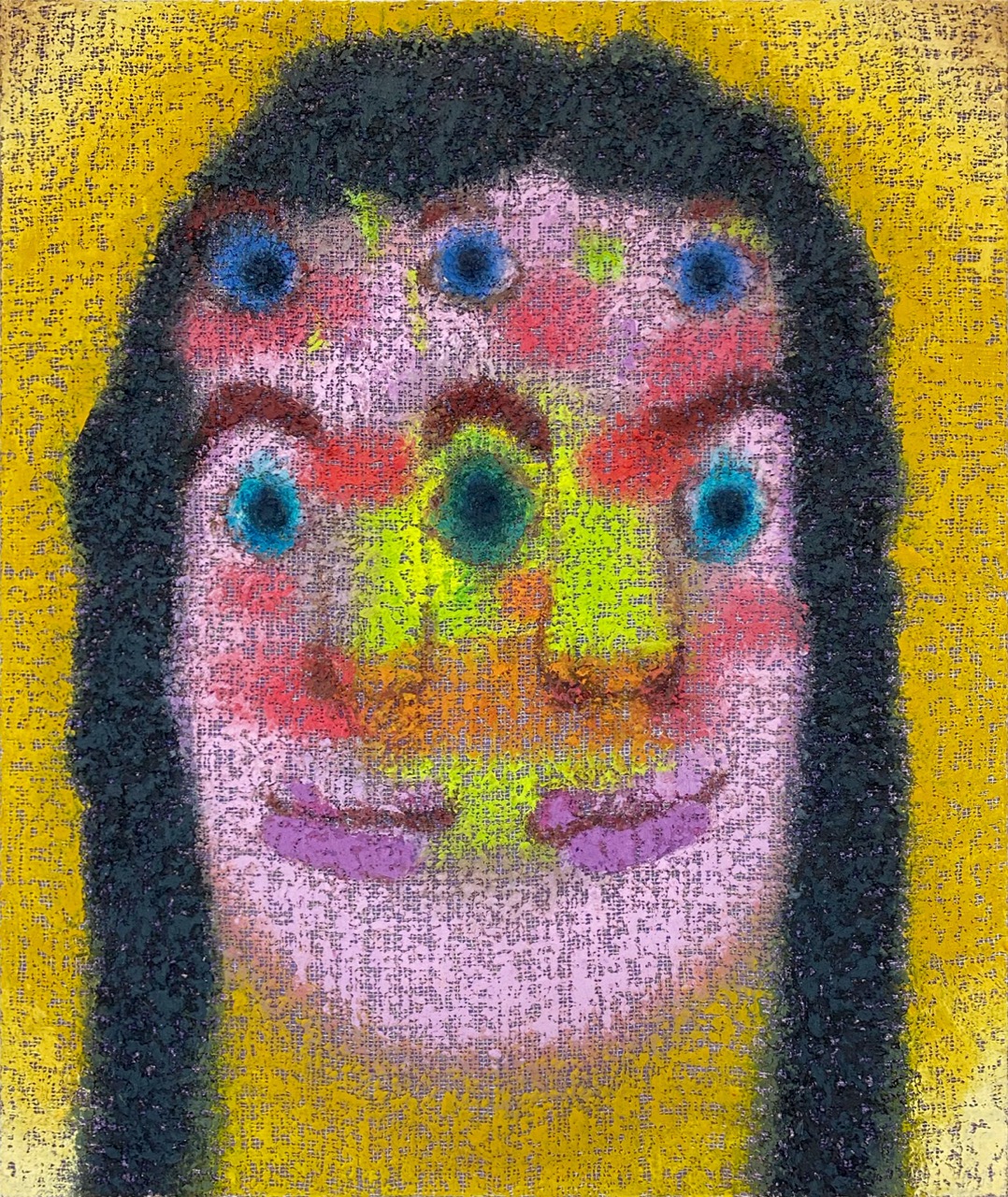 Inna LevinsonDouble-Faced (2), 2022
Inna LevinsonDouble-Faced (2), 2022 -
 Inna LevinsonDouble-Faced (4), 2022
Inna LevinsonDouble-Faced (4), 2022 -
 Inna LevinsonDouble-Faced (5), 2023
Inna LevinsonDouble-Faced (5), 2023 -
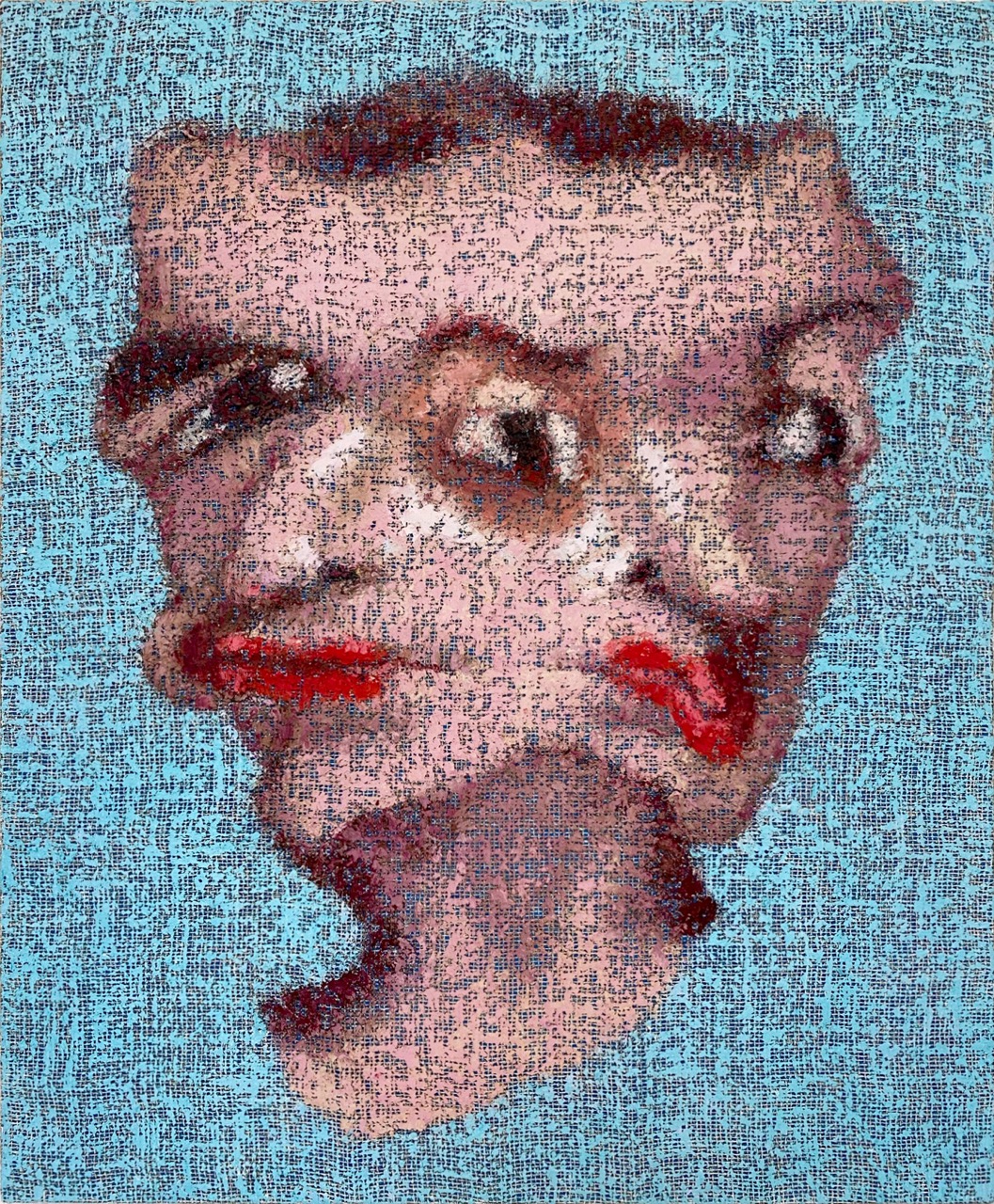 Inna LevinsonDouble-Faced (1), 2022
Inna LevinsonDouble-Faced (1), 2022 -
 Inna LevinsonDouble-Faced (3), 2023
Inna LevinsonDouble-Faced (3), 2023
×
